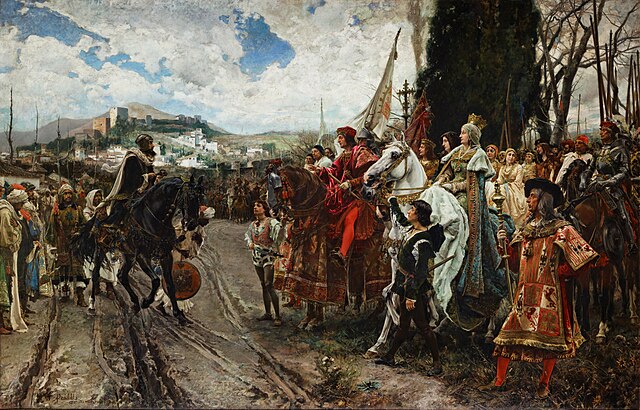New Spain, officially the Viceroyalty of New Spain, originally the Kingdom of New Spain, was an integral territorial entity of the Spanish Empire, established by Habsburg Spain. It was one of several domains established during the Spanish conquest of the Americas, and had its capital in Mexico City. Its jurisdiction comprised a large area of the southern and western portions of North America, mainly what is now Mexico and the Southwestern United States, but also California, Florida and Louisiana; Central America, the Caribbean, and northern parts of South America; several Pacific archipelagos, most notably the Philippines and Guam. Additional Asian colonies included "Spanish Formosa", on the island now known as Taiwan.
Hernán Cortés and La Malinche meet the emperor Moctezuma II in Tenochtitlán, November 8, 1519.
The evangelization of Mexico
An auto-da-fé in New Spain, 18th century
Vázquez de Coronado Sets Out to the North (1540), by Frederic Remington, oil on canvas, 1905
The Spanish Empire, sometimes referred to as the Hispanic Monarchy or the Catholic Monarchy, was a colonial empire that existed between 1492 and 1976. In conjunction with the Portuguese Empire, it ushered in the European Age of Discovery. It achieved a global scale, controlling vast portions of the Americas, Africa, various islands in Asia and Oceania, as well as territory in other parts of Europe. It was one of the most powerful empires of the early modern period, becoming known as "the empire on which the sun never sets". At its greatest extent in the late 1700s and early 1800s, the Spanish Empire covered over 13 million square kilometres, making it one of the largest empires in history.
Crowns and kingdoms of the Catholic Monarchs in Europe (1500)
The Capitulation of Granada by F. Pradilla: Muhammad XII (Boabdil) surrenders to Ferdinand and Isabella.
El gran capitán at the Battle of Cerignola.
The conquest of the Canary Islands (1402–1496)








